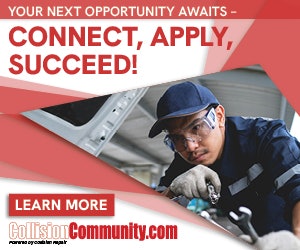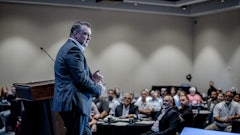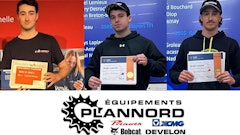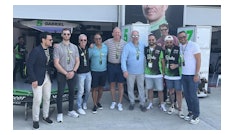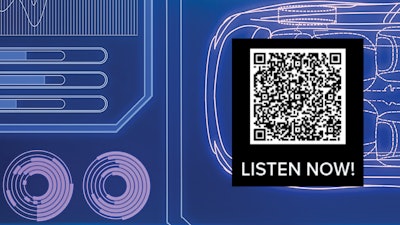
HUNTER ENGINEERING’S ROSS IACOBELLIS OUTLINES THE MUST-KNOWS OF ADAS CALIBRATION—FROM TRAINING AND PRECISION TOOLS TO AVOIDING COSTLY MISTAKES AND PREPARING YOUR SHOP FOR THE FUTURE
ADAS calibration isn’t just a technical step—it’s a vital safety function, and one that repairers can’t afford to get wrong. As these systems become standard in nearly every new vehicle, the collision repair industry is under increasing pressure to deliver precise, OEM-compliant calibrations—efficiently, consistently and transparently.
In this in-depth conversation, Collision Repair magazine’s Allison Rogers connects with Ross Iacobellis, Technical Specialist at Hunter Engineering, to explore how shops can rise to the challenge. From space and staffing requirements to emerging trends in training and technology, Iacobellis outlines what it takes to succeed in the ADAS space—and how Hunter is supporting that success.
Whether you’re thinking about introducing ADAS services or looking to improve your current offering, this Q&A provides practical insight into the tools, systems and mindset needed to get calibration right the first time—every time. Scan the QR code or visit www.collisionrepairmag.com/podcast to listen to the full episode.


Ross Iacobellis: Thanks, Allison! I’m a technical specialist in sales. I support the Canadian market and collaborate with our St. Louis team as needed. I provide technical guidance for our sales force, lead distributor and customer training sessions, and help shops and dealers across Canada navigate the ADAS space. Our Aurora, Ont., facility hosts in-depth training sessions, and I’m involved in ensuring clients understand how our tools streamline calibrations while adhering to OEM standards.
CRM: Let’s start with the basics. ADAS systems vary widely across automakers. What should repairers keep in mind?
RI: OEM procedures drive everything. Each automaker—and sometimes even different models—can have unique calibration steps. Some systems are camera-based, others use radar, and most vehicles combine multiple systems. These could include adaptive cruise control, lane departure warnings or blind spot detection. Accurate calibration is essential for them to work as intended.
CRM: And why is it so important to follow OEM procedures exactly?
RI: Tolerance levels are incredibly tight— often within one millimetre. If your camera is off by that much, the calibration target could be metres out of place. Our Ultimate ADAS system ensures we hit that bullseye every time and verifies accuracy before letting the technician proceed.
CRM: Who in a facility needs to understand ADAS calibration—just the technician?
RI: It’s a team responsibility. Technicians obviously need to know the systems, but shop owners must understand the liability, and counter staff need to explain calibration work to customers. Transparency builds trust, and our systems produce detailed reports that clarify what was done and why.
CRM: What are some challenges shops face when implementing ADAS calibration services?
RI:The biggest ones are environmental— level floors, lighting and space. Then it’s training. Technicians need to understand the systems they’re working on and when a calibration is needed. Not every ADAS system requires recalibration after service, but many do, and you need to know which is which.
CRM: What about calibration errors—how dangerous are they?
RI: Extremely. Calibration errors directly impact vehicle safety. A small mistake could mean a vehicle doesn’t react correctly to an obstacle. That’s why our system double-checks technician inputs and ensures accuracy throughout the process. It doesn’t let you proceed until you’re within tolerance.
CRM: Procedures change quickly. How can technicians stay up to date?
RI: It’s not easy. Our machines receive quarterly updates, and our scan tools are updated monthly. Technicians need to read those updates, follow industry bulletins and stay involved in communities and forums. The techs who succeed are the ones who put in that effort.
CRM: How does Hunter guarantee its equipment is calibrated correctly?
RI: We calibrate and test every machine before installation. Each morning, when a technician powers up the Ultimate ADAS system, it performs an automatic calibration check before the first job. If it fails, it stops the process and prompts recalibration.

RI: We’ve launched Hunter University—a free e-learning platform with 14 certificatebased ADAS modules. It’s open to anyone and includes tests and downloadable certificates. We also have the Hunter Learning Channel on YouTube with vehicle-specific calibration walkthroughs. Plus, we’ve begun offering in-person training in Western Canada and Quebec, with plans to expand across the country.
CRM: How important is certification for shops?
RI: It’s crucial. It shows insurers and customers that your team is trained. Insurers want calibrations done right, the first time. Shops that can do that will stand out—and win more business. Plus, it’s a great career path for technicians, especially younger ones looking to specialize.
CRM: Some think ADAS calibrations are a cash grab. Is that true?
RI: It can be lucrative, but only if you’re prepared. Do your research. Understand your local market, your facility’s capabilities, and choose a reliable partner. The worst thing is buying equipment and not using it. Our goal is to support shops that want to use our tools properly—not let them gather dust.
CRM: What are the key costs involved?
RI: Space, trained staff, and the right tools. Our Ultimate ADAS also handles wheel alignments, so it offers dual revenue potential. Costs will vary by shop, especially depending on what makes and models you service. Updates and new target systems are offered a la carte so shops can scale up as needed.
CRM: How are insurers handling ADAS calibrations in Canada?
RI:Typically, insurers pay per calibration. Some systems require both static and dynamic calibrations, which are billed together. Across Canada, we see prices ranging from $300 to $375 per calibration. At the end of the day, everyone wants the car fixed correctly—once.
CRM: Final thoughts for shops considering ADAS services?
RI: Don’t be afraid to learn. Invest in your team. Visit hunter.com and check out the ADAS hub—we’ve packed it with information. Whether you’re just starting or looking to grow your services, the key is education and preparation.
CRM: Thanks, Ross. It’s always a pleasure to speak with you.
For anyone interested in ADAS, be sure to check out the resources Ross mentioned, and stay tuned for more episodes of Industry Insider.

